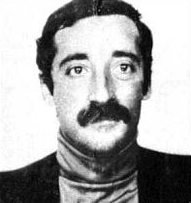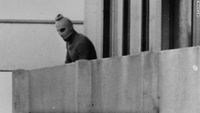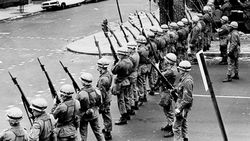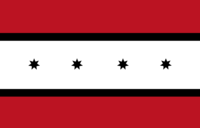The Troubles
| The Troubles | |||||||
|---|---|---|---|---|---|---|---|
 Top left: FCA with artillery, 1989 Top right: AFF bombing in Avergís, 2015 Bottom left: Riot police on fire after molotov attack, 2019 Bottom right: Brotherhood of Allah fighters, 1964 | |||||||
| |||||||
| Belligerents | |||||||
|
Supported by: Supported by: |
Supported by: Defunct: Knights of Hégeis (1959-1971) |
Supported by: Defunct: Sayf al-Islam (1970-1976) Hizbul Mujahideen (1973-1994) |
Supported by:
Defunct: Anti-Virátist Coalition | ||||
| Commanders and leaders | |||||||
|
23px Mige Ert 23px Akim Sicolt † |
|
23px Rauia Ibrahim 23px Muamet Thezmar † |
| ||||
| Strength | |||||||
|
23px 150 |
| 23px 3,000 |
| ||||
The Troubles (Terranilian: Sen Koisten) is an ongoing conflict in Terranihil which began in 1960. Although the conflict has been concentrated in a few major cities, the violence has spread throughout Terranihil, Póniepa, Lyoa and Malgax. The conflict is mainly fueled by religious differences between atheists, Muslims and Christians, though there is also an ethnic aspect.
The National Progressive Party (NPP) has implemented many laws which restrict religious practice since its rise to power in the Progressive Revolution in 1941; however, violence against the religious significantly increased after the assassination of Omar Lornif, the second Chairman of the NPP and Žep Virát's right-hand man, on October 1, 1960 by a Muslim militant. The Terranilian government responded by arresting and executing about 200 Muslims who were accusedly connected to the assassination. The government increased limitations on places of worship and religious attire in public of both Muslims and Christians. Furthermore, in the month following the assassination, many Muslims and Christians were killed by atheist rioters seeking retribution. This prompted mass protests and the formation of several religious paramilitary organizations intent on ending the NPP's discrimination and violence against Muslims and Christians.
The main participants in the Troubles are Muslim paramilitaries such as the Alhaz Freedom Fighters and the Brotherhood of Allah, Christian paramilitaries such as the Free Christian Army, the Terranilian government, and pro-NPP paramilitaries such as the Vigilant Atheists. Other minor combatants include the Democratic Forces for the Liberation of Terranihil and the Póniepan Armed Forces. The Muslim and Christian paramilitaries use guerilla warfare against Terranilian security forces, as well as attack infrastructure, commercial, and political targets. The insurgents frequently target atheist civilians and occasionally other religious groups. Pro-NPP paramilitaries target Muslim and Christian civilians, as well as insurgents. The Terranilian government acts in an anti-insurgent role, but has been accused of targeting innocent civilians and colluding with pro-NPP paramilitaries; Terranilian police and the Department of Internal Security (DIS) are the forces in combat with insurgents.
More than 11,500 people have been killed in the conflict, of whom 59% were civilians, 25% were Terranilian security forces and 16% were paramilitaries. The violence has been consistant from the beginning of the conflict until today.
Contents
Background
Terranihil has been a place of religious conflict ever since the spread of Christianity in the 4th century and Islam in the 7th century. Christians, Muslims and pagans were in near constant conflict from the 6th to the 13th century. The Devraifian Wars in which the Kingdom of Terranihil conquered and reunited Terranihil is considered the last religious war of Terranihil, but religious rebelions and insurgencies have continued. The kingdom, which was ruled by pagans, restricted Judeo-Christian practices, disqualified Christians and Muslims from high government positions and violently suppressed religious protests and opposition. The 15th to 19th century saw the conversion of most pagans to atheism.
The later years of absolute monarchy and the shift to a constitutional monarchy in 1609 saw more leniency by the ruling class and an increase in religious freedoms. After the Terranilian Civil War (1879-1890), which was mainly politically motivated rather than religiously, the Republic of Terranihil was established, which led to an era of cooperation by all religious groups.

In 1941, the National Progressive Party (NPP) gained control of the country in the Progressive Revolution. The party is strictly atheist and antireligious. Žep Virát, the founder of the NPP and its first chairmen, who served from 1938 to 1954, passed many laws that decreased the religious rights of Muslims and Christians, but religious insurgent activity was not prevalent. The Etlan insurgency from 1944 to 1956 is considered a conflict separate from the Troubles because it was mostly a politically motivated conflict, though some religiously motivated insurgent groups such as the Militant Christian Socialists were involved.
On October 1, 1960, Abdulkader Hamdi, a Muslim who had previously been arrested for possible religious extremism, assassinated Chairman Omar Lornif in the streets of Guršaun with a pistol. The NPP and the atheist populace at large were outraged. The Terranilian government executed Hamdi, and then arrested and executed about 200 Muslims who were supposedly associated with him. Furthermore, atheist mobs seeking retribution killed about 70 Muslims and 11 Christians in the week following the assassination. The government increased restrictions on both Muslims and Christians by closing down several mosques and churches, banning all religious attire from Guršaun, Intemil, Tolongen and several other atheist majority cities, and putting Avergís, the largest Muslim city in Terranihil and Hamdi's home city, under martial law.
1960s
Inital protests
The arrests and executions by the Terranilian government and rioters and the increased persecution of Muslims and Christians prompted mass protests mostly in Avergís and Hégeis. Despite being under martial law and public meetings of more than five people being temporarily banned, thousands of Muslims in Avergís protested the government in October of 1960. Protests against increased persecution and vigilante killings in Hégeis also occurred but to a lesser extent. Police attempted to put down protests by deploying tear gas and arresting protesters.
On October 11, several protesters engaged in physical altercations with police, who then deployed tear gas. Protestors began throwing rocks at police and started several fires. The police, although reportedly instructed by the Avergísian police chief to not open fire as to not escalate the situation, shot at protestors. Many protestors rushed the police and overwhelmed and attacked several officers. One protester rammed officers with a car. After two hours of continuous conflict, the police and GÉC (Armed Special Police) suppressed the protest. Ten police officers and 88 protesters were killed. This became known as the October Massacre.
Protests continued for forty more days and spread to other cities, including Intemil and Guršaun. In Hégeis, several thousand people protested the government's actions and demonstrated their solidarity for the Muslim deaths in Avergís. On November 1, many Christians in Hégeis protested the kidnapping of political enemies by Terranilian forces. An incident similar to the October Massacre occured in which protesters and police began fighting and the police opened fire. About twenty Christians were killed.
More than 350 protesters and thirty police officers were killed in total from October 1 to November 20. The Terranilian police and the Department of Internal Security (DIS) continued to restrict religious practice and enforce draconian punishments against Muslims and Christians. The police eventually quelled the protests; however, altercations between police and religious citizens continued, as did the kidnappings, arrests and executions.
Formation of insurgent groups
Before 1960, insurgent groups were small and disorganized to the point of being unrecognized by the Terranilian government as major threats; individual actors like Abdulkader Hamdi were more common. After the protests and mass shootings, Muslims and Christians began organizing groups to fight against the Terranilian government. Most citizens were. unwilling to take up arms against the government; the minority that did tended to be ideologically extreme, hence the formation of militant Islamic and Christian groups.
Brotherhood of Allah
In Avergís, a small number of Alhaz Muslim men who managed the now destroyed Alawal Mosque formed the Brotherhood of Allah, an Islamic militant group intent on ending government control over the Muslim majority east of Terranihil. They recruiting in the many mosques of Avergís and the surrounding cities. Public knowledge of the Brotherhood of Allah was unknown until January 17, 1961, when the group attacked and killed two police officers on patrol. The Terranilian government responded by arresting twenty Muslims who likely unrelated to the murders. The brotherhood committed several similar small attacks throughout 1962.
On December 8, 1962, after the police fatally shot two Muslim teenagers who they wrongly beleived were suspects for a crime, the Brotherhood of Allah detonated a car bomb in the NPP's headquarters in Avergís, killing thirteen people. This was the first major terrorist attack of the Troubles. At the time, the brotherhood likely had about sixty members; however, it began to rapidly grow in numbers following the attack. By the end of 1964, the group was estimated to have over two hundred "brothers". It also began recruiting in other cities such as Intemil. In May 17, 1964, a sixteen year old boy detonated an IED in a crowded hotel in Intemil, killing himself and thirty others, which marked the Brotherhood of Allah's first major attack outside of Avergís. A similar attack occured in December of 1965, in a hotel in Avergís.
The Terranilian government responded to the attacks with the typical mass arrests and executions. The Brotherhood of Allah's founder, Sachet Mumateni in 1966. The loss of the founder destabilized the group until Gor Amír took lead of the brotherhood. Amír beleived it was time for Avergís to take a stand against the Terranilian government. He led the group in carrying out more spectacular attacks, rather than the mostly low level insurgent activity under Mumateni. On April 2, 1968 at 2 AM, about twenty-five members of the Brotherhood of Allah attacked a police station in Avergís. They successfully entered the station and killed all of twenty police officers within. They stole weapons and files and fled the scene. About half of the attackers were killed, but they had demonstrated that they were able to carry out outright attacks on Terranilian law enforcement.
On Christmas day, 1969, after much preparation, Amír and about eighty Brotherhood of Allah members stormed the capitol building of Avergís in a plan to take control of the city. They succesfully captured the building and took forty hostages, including several city assembly members. They not only secured the building but also held a two kilometer radius zone around the building. After five hours of fighting, the police and GÉC forces had pushed the Brotherhood of Allah back into the capitol building. The police attempted to negotiate with the hostage takers for seven more hours. They had determined that out of the thirty remaining hostages, twenty-seven were Muslim. The DIS and Terranilian Army disregarded the hostages and initiated an attack on the capitol building. The army successfully killed all of the attackers, including Amír, and recaptured the capitol; however, all forty hostages were killed. The attack became known as the Christmas Day Battle.
Knights of Hégeis
On December 28, 1959, several men kidnapped and beat to death an atheist police officer in Hégeis and left his body at his family's doorsteps. The attackers also vandalized the home with the phrase "We are the Knights of Hégeis". A similar attack against two homosexuals occured on January 11, 1960 and another against a Muslim woman on February 22. The police arrested nineteen year old Dan Marth for both of the attacks, who admitted that he was part of a group of young men calling themselves Knights of Hégeis. From 1960 to 1962, the group killed thirty people. Several arrests of men from ages seventeen to twenty-four were made.
In 1963, Jona Chiltadam, a retired army veteran, became the leader of Knights of Hégeis. He turned the group away from the murders of individual targets to larger scale terrorist attacks similar to those of the Brotherhood of Allah. On June 12, 1963, they detonated an IED at Hener Halm Radio Station for mocking Jesus Christ and the Bible. The attack killed no one but signified Knights of Hégeis's change to legitimate insurgents.
The group carried out about 40 attacks from 1964 to 1971, claiming about 130 lives. The police captured Chiltadem in August of 1969. Despite his seeming dedication to the cause of Knights of Hégeis, he helped the police and DIS arrest many other members. The group began to fall apart after his arrest.
1970s
New Islamic insurgents
Hizbul Mujahideen
The failure of the Christmas Day Battle destabilized the Brotherhood of Allah. The insurgents carried out a few minor attacks in 1970 and 1971. In September of 1971, many members of the Brotherhood of Allah left the group and formed Hizbul Mujahideen, which mainly operated in northwestern Terranihil, while the Brotherhood of Allah was mainly in the southwest. Hizbul Mujahideen conducted several suicide bombings from 1971 to 1976. Hizbul Mujahideen ran an underground newspaper which frequently mocked Chairman Merol Bróth for being bisexual.
After the Alhok Massacre on November 3, 1972, in which the Terranilian police killed thirty-two Muslim men, Hizbul Mujahideen perpetrated the Tolongen wedding massacre in revenge, killing twelve atheists at a wedding in Tolongen.
On October 3, 1974, Hizbul Mujahideen attempted to assassinate Bróth while on a visit to Intemíl. Hizbul Mujahideen placed an IED near the entrance of the hotel that Bróth was staying at. However, the explosive accidently detonated too early and instead killed three Muslim civilians. The DIS increased its campaign efforts against the group after the attack until it became defunct in 1976.
Sayful Islam
After losing much of its already decreasing membership to Hizbul Mujahideen of Islam in 1971, the Brotherhood of Allah collapsed in 1972. Sayful Islam formed from some of the Brotherhoods members. Hizbul Mujahideen overshadowed Sayful Islam as the more dangerous group from 1973 to 1975, as Sayful Islam had few members. However, it became more prominent after the decline of izbul Mijahideen. Sayful Islam killed over 200 people from 1973 to 1979. Its most deadly attack in the 1970s was the Andaluzian Yacht bombing in 1977, in which several Sayful Islam insurgents detonated two bombs on a commercial Yacht in the Andaluzian ocean, killing forty people.
In 1978, Sayful Islam established a wing of insurgents in eastern Terranihil called the Hizbul Mujahideent-East Wing (SIEW). SIEW primarily targeted government buildings and officials. It coordinated with Mara Salvatrucha, a Creeperian gang, to smuggle drugs into eastern Terranihil in exchange for weapons. SIEW also fought against the Free Christian Army on a few occasions, including the Jofrais Street shootout in Carmie on October 7, 1979, which killed six SIEW insurgents, five FCA insurgents, and five bystanders.
Free Christian Army
In February of 1973, Muza Chilmariem, a fundamentalist Christian from Hégeis, met with several other Christians, including Jon Vik, an ex-member of Knights of Hégeis, and formed the Free Christian Army (FCA), a Christian insurgent group dedicated to combatting the Terranilian government. The group recruited heavily in Hégeis, with several old Knights of Hégeis members joining. Their first major attack was on February 28, 1973, in which detonated an IED near a police station, killing four police officers. The FCA also engaged in a string of killings of atheists, Muslims, and homosexuals from April 1973 to January 1974, which claimed forty lives and was most likely led by Vik. On January 20, 1974, Vik and Chilmariem got into a dispute which had been culminating for several months; Chilmariem and several other FCA members killed Vik and seven of his supporters in the Holi bar shooting, which also claimed an additional six civilian lives.
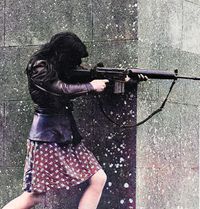
On September 2, 1974, the FCA assassinated Odri Honte, a world famous Terranilian actor for insulting Christianity. On June 11, 1975, five FCA insurgents opened fire on a gay rights protest in Guršaun, killing thirty five people; only one of the shooters was caught. The FCA killed about 100 people from 1973 to 1975. They had grown to 130 insurgents by the end of 1975. The Militarist Nationalist Front, or FRENAMI, had expressed public support for the FCA and possibly began providing the group with weapons in 1975.
In 1976, the Free Christian Army-West Battalion (FCA-WB) formed, which operated in western Terranihil and was headquartered in Prót governorate. FCA-WB mostly targeted Muslim civilians. On December 5, 1976, they arson attacked a mosque in Zakaria, Mumeten governorate, killing twelve people, including four children. FCA-WB also frequently used Islamophobic tactics such as nailing a pigs head to mosque's door or vandalizing Muslim homes.
On April 23, 1977, Chilmariem and his family were arrested by Terranilian authorities after a raid conducted on his home. He and his wife were tortured for information and then executed by hanging. Gabriel Frél took leadership of the FCA. In retaliation for Chilmariem's execution, the FCA bombed the courthouse at which he was tried on August 2, 1977, killing nine people. On March 6, 1979, the FCA assassinated the brother of Chairman Merol Bróth. The group remained stable under the new leadership and conducted several attacks from 1977 to 1979, killing 120 people.
Fifth Póniepan rebellion
- Main article:Fifth Póniepan rebellion
On September 24, 1975, Bróth publically ordered Governor Agerno Keskes of Póniepa to resign, an unprecedented action by any previous Terranilian president. Bróth wanted to replace the governor with Sitham Osaak, a parliamentarian more compliant with the NPP. Bróth's eventual plan, as revealed by documents leaked in 1990, was to end Póniepa's longtime status as an autonomous governorate. Keskes refused to step down, so Bróth mobilized forces to invade Biezpaan, the capital of Póniepa.
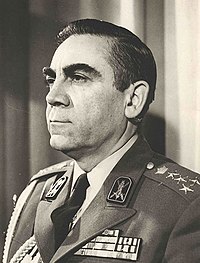
Keskes ordered the Póniepan Army Corps to defend the city. The 5,000 Póniepan troops were largely outnumbered by the 17,000 strong initial Terranilian force; the Terranilian air force was also superior than Póniepa's air force. General Samán Lomb who commanded the Terranilian army led the army to Lunie, Mortík. However, he refused to continue further despite direct orders from Bróth. Lomb's army remained stationary for nine days. The Póniepan forces took advantage of the delay by fortifying the governorate capital of Biezpaan.
On October 10, Bróth threatened to mobilize more forces against the halted army. Several officers and about 200 soldiers attempted to arrest General Lomb, leading to the Battle of Lunie. After several hours of infighting, Lomb and his loyal officers were arrested and later executed. General Kain Gát, son of famous General Adam Gát, arrived in Lunie on October 11 with 5,000 soldiers and siezed control of the army. By then the morale of the soldiers had decreased significantly, but Gát began the march toward Biezpaan.
Most Póniepan forces had barricaded themselves in Biezpaan, but a few hundred soldiers were sent to conduct guerilla attacks against the marching army. They hid explosives along the path of the army to destroy tanks, ambushed companies, and set up barricades to divert the march. Although the guerilla warfare did not claim many lives, the contant minor attacks combined with the rugged terrain and cold weather further demoralized the Terranilian army.
The army arrived at Biezpaan on October 18 with air support. The small Póniepan air fleet deployed to combat the Terranilian planes that outnumbered them four to one. The Póniepan planes were quickly defeated, and the Terranilian fighters began a barrage against the city. On the ground, the Terranilian army set up artillery and began shelling the city. The Póniepans responded with their own artillery. Several detachments of soldiers attempted to enter the city but were repeatedly repelled by the Póniepans. Fighting continued until the 21st, when Biezpaan surrendered because of the constant bombardment from the air. The Terranilian army captured the city, and Governor Keskes resigned and surrendered. The four day battle became known as the Siege of Biezpaan.
Although the Terranilians had captured the capital city of Póniepa, many Póniepans throughout the governorate refused to abide the orders of the capital while military occupation. Bróth wished to continue the campaign and capture more cities, but his military advisors insisted that such a campaign in the harsh mountains would likely be unseccussful. Furthermore, guerilla attacks against the Terranilian forces continued. On November 3, the Terranilian army withdrew. Bróth had appointed Osaak as the governor, but most Terranilian did not view the events positively. The Terranilian army sustained many casualties and was demoralized, and Póniepa had managed to resist Terranilian occupation.
1980s
Seizure of Hégeis
- Main article:Seizure of Hégeis
From 1980 to 1983, the FCA killed more than 120 people and the FCA-WB, which suffered heavy losses in the early 1980s from police raids and a lack of recruitment, killed 24 people. Planning for the seizure of Hégeis began in February and March of 1984. On the morning of 23 May 1985, ninety-seven FCA soldiers led by Frél attempted to seize the city of Hégeis. The plan for the attack was supposedly inspired by the Christmas Day battle. Half of the FCA attackers seized the capitol building, killing the police guarding the building, but taking no hostages; they then began forming a perimeter and setting up barricades. The other half seized Hégeis Central Park and also set up barricades. The police initially responded in mass to the capitol building and a firefight erupted between the FCA and police. Security forces at Central Park were overwhelmed and forced to retreat. About two thousand citizens rallied at the park in an unplanned demonstration in support of the FCA.
The police regrouped at the capitol building. Although the police reinforcements began to tip the scales against the FCA at the capitol, several hundred protestors began pushing away police. Although the protestors were officially considered part of the same threat as the FCA, police were hesitant to use force, let alone fire their weapons, against the demonstrators. The FCA continued to take streets and blocks of the city until the two halves of the FCA had rejoined and they had captured about ten square kilometers by 7 PM. The protests had increased in size and surrounded the inner city. The Army had arrived but were unable to engage with the FCA because the protestors.
Military and police surrounded the inner city at night as protests continued to grow. At 5 AM on 24 May,the Army launched an assault, pushing through protestors who decreased in number over night. The military moved used armored vehicles bush through barricades. Several IEDs that had been placed as traps killed security forces. Helicopters provided air support. The FCA defenses were easily defeated by the military's firepower. Riot police subdued and pushed back protestors from the military's assault. The assault successfully took Hégeis Central Square in an hour. When the security forces reached the capitol building, most of FCA soldiers fled instead of attempting to barricade themselves in the capitol building. Terranilian security forces recaptured the capitol building and the rest of the city.
After holding Hégeis for twenty hours, the army and police had defeated the FCA. 95 security personnel, more than 100 FCA soldiers, and more than 120 civilians were killed. Gabriel Frél was killed in the final assault. The city was placed under martial law for sixty days following the attack. Police and the DIS arrested more than forty people accused of participating in the attack.
The FCA had taken heavy losses and remained quiet for most of the year of 1984. FCA-WB had completely collapsed by June of that year. Leadership seemingly passed on to Augustus Ichigožt. The FCA's activity slowly recuperated in 1985 and 1986, with the group perpetrating relatively minor attacks, killing 18 police and military personnel in those two years. The increased policing in Hégeus following the attack stunted the group's growth; however, public image and recruitment increased considerable in the late 1980s, with many Christians seeing the seizure as positive act of resistance against government oppression. From 1987 to 1989, the FCA killed about 30 security personnel.
Atheist militias
1980-1989
Continued Sayful Islam operations
1980-1989
Anti-Virátist Coalition
1983-1988
1990s
1992 coup attempt
End of Sayful Islam
1990-1994
Alhaz Freedom Fighters
1994-1999
Continued FCA operations
1990-1999
Nationalist Volunteer Militia
1995-1999
21st Century
Increased militarization
Continued AFF operations
2000-2020
Continued FCA operations
2000-2020
Vigilant Atheists
2002-2020
Democratic Forces for the Liberation of Terranihil
2010-2020
Malgan ethnic cleansing
2020


